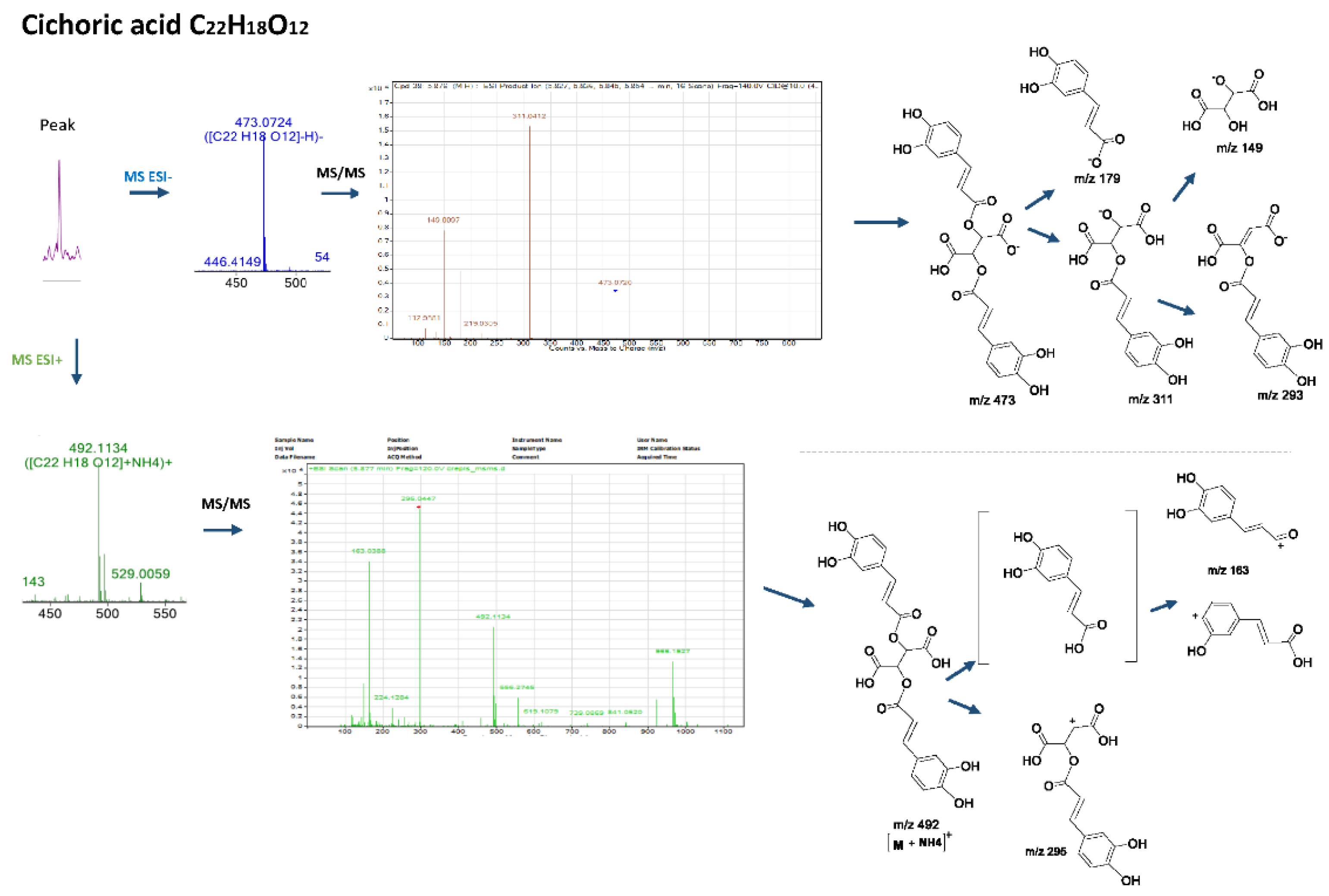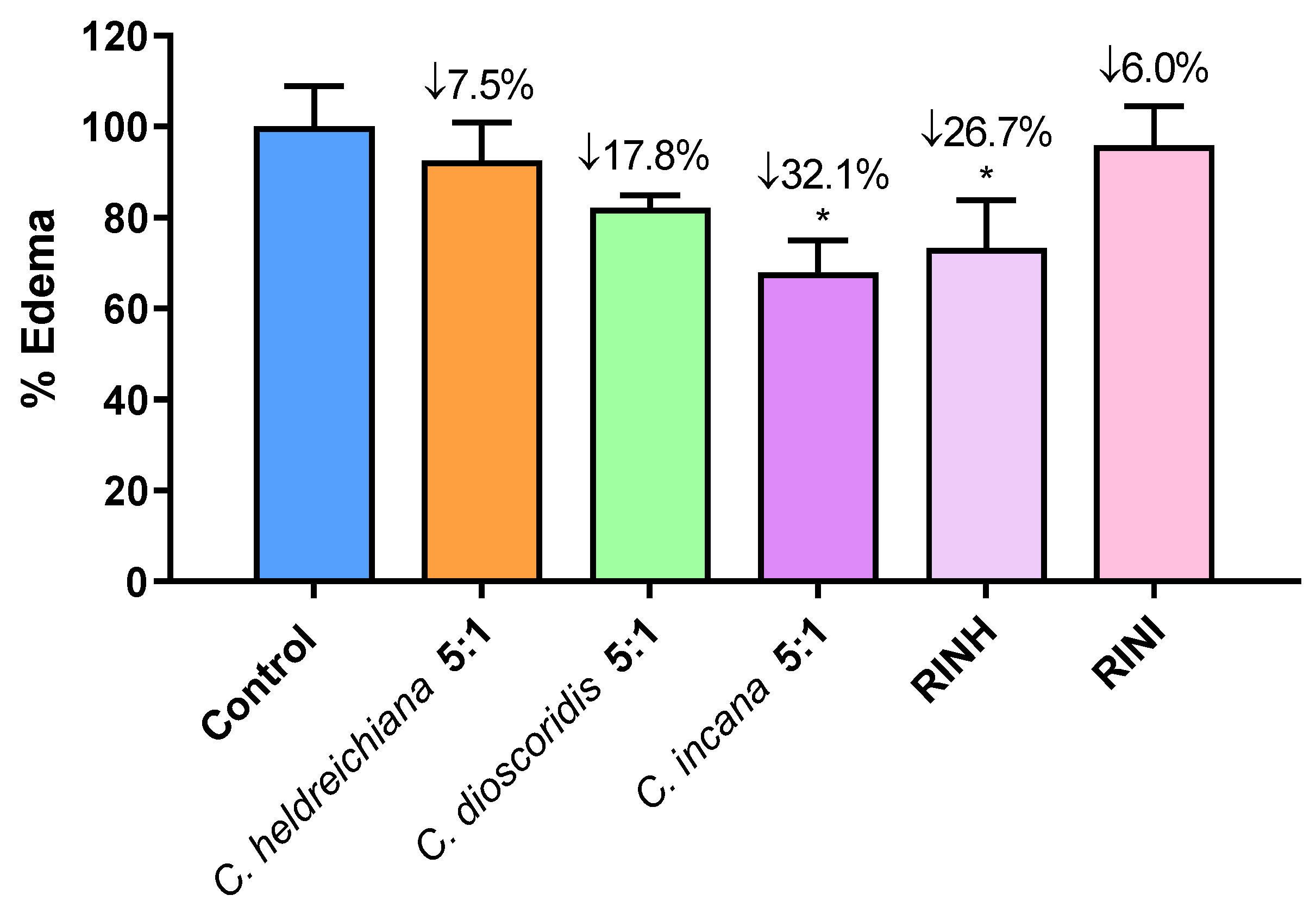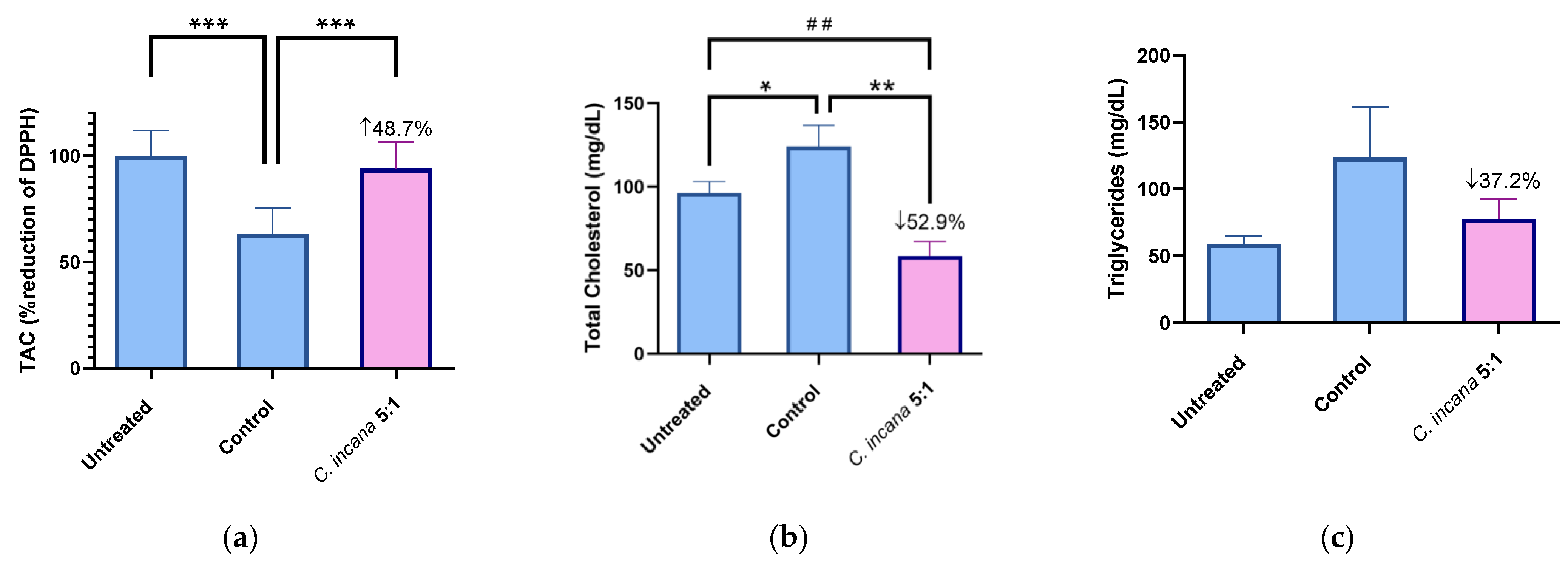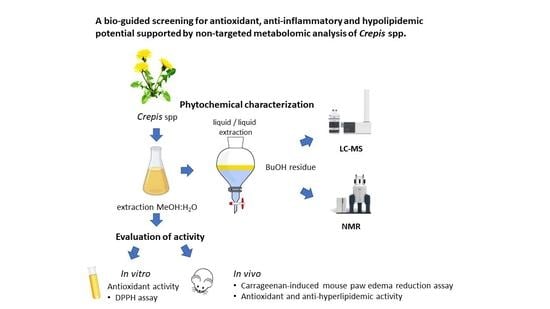A Bio-Guided Screening for Antioxidant, Anti-Inflammatory and Hypolipidemic Potential Supported by Non-Targeted Metabolomic Analysis of Crepis spp.
Abstract
:1. Introduction
2. Results and Discussion
2.1. Phytochemical Characterization of Selected Extracts
2.1.1. NMR Characterization of Selected n-Butanol Extracts
2.1.2. LC-MS Characterization of Selected n-Butanol Extracts
2.1.3. Total Phenolic Content
2.2. In Vitro and In Vivo Activities
2.2.1. Evaluation of Antioxidant Activity In Vitro, DPPH Assay
2.2.2. Evaluation of Anti-Inflammatory Activity (In Vivo)
2.2.3. Evaluation of (In Vivo) Antioxidant and Anti-Hyperlipidemic Activity
2.3. Pharmacological Profile of Crepis spp.
3. Materials and Methods
3.1. Plant Material
3.2. Extraction and Isolation
3.3. Nuclear Magnetic Resonance (NMR) Spectroscopy
3.4. Liquid Chromatography High-Resolution Quadrupole Time-of-Flight Mass Spectrometry (LC-Q-TOF-MS/MS)
3.5. In Vitro Activity
3.5.1. DPPH (2,2-Diphenyl-1-Picrylhydrazyl) Radical Scavenging Assay
3.5.2. Total Phenolic Content-Folin–Ciocalteu(F-C) Protocol
3.6. In Vivo Activity
3.6.1. Animals
3.6.2. Carrageenan-Induced Paw Edema Reduction Assay
3.6.3. Hypolipidemic Activity Assay
3.7. Statistical Analysis
4. Conclusions
Supplementary Materials
Author Contributions
Funding
Institutional Review Board Statement
Data Availability Statement
Acknowledgments
Conflicts of Interest
References
- Zidorn, C. Sesquiterpene lactones and their precursors as chemosystematic markers in the tribe Cichorieae of the Asteraceae. Phytochemistry 2008, 69, 2270–2296. [Google Scholar] [CrossRef] [PubMed]
- Shulha, O.; Zidorn, C. Sesquiterpene lactones and their precursors as chemosystematic markers in the tribe Cichorieae of the Asteraceae revisited: An update (2008–2017). Phytochemistry 2019, 163, 149–177. [Google Scholar] [CrossRef] [PubMed]
- Zidorn, C. Bioprospecting of plant natural products in Schleswig-Holstein (Germany) I: Chemodiversity of the Cichorieae tribe (Asteraceae) in Schleswig-Holstein. Phytochem. Rev. 2019, 18, 1223–1253. [Google Scholar] [CrossRef]
- Salehi, B.; Azzini, E.; Zucca, P.; Maria Varoni, E.V.; Anil Kumar, N.; Dini, L.; Panzarini, E.; Rajkovic, J.; ValereTsouhFokou, P.; Peluso, I.; et al. Plant-Derived Bioactives and Oxidative Stress-Related Disorders: A Key Trend towards Healthy Aging and Longevity Promotion. Appl. Sci. 2020, 10, 947. [Google Scholar] [CrossRef]
- Barda, C.; Ciric, A.; Soković, M.; Tsoukalas, M.; Skaltsa, H. Phytochemical investigation of Crepisincana Sm. (Asteraceae) endemic to southern Greece. Biochem. System. Ecol. 2018, 80, 59–62. [Google Scholar] [CrossRef]
- Badalamenti, N.; Sottile, F.; Bruno, M. Ethnobotany, Phytochemistry, Biological, and Nutritional Properties of Genus Crepis—A Review. Plants 2022, 11, 519. [Google Scholar] [CrossRef] [PubMed]
- Kotti, I.; Barda, C.; Karioti, A.; Skaltsa, H. Sesquiterpene lactones and other secondary metabolites from Crepiscommutata (Spreng.) Greuter–Asteraceae. Biochem. Syst. Ecol. 2019, 86, 103917. [Google Scholar] [CrossRef]
- Tsoukalas, M.; Gousiadou, C.; Skaltsa, H. Sesquiterpene lactones and phenolics from Crepisdioscoridis L., growing wild in Greece. Phytochem. Lett. 2014, 7, 202–206. [Google Scholar] [CrossRef]
- Sut, S.; Tahmasebi, A.; Ferri, N.; Ferrarese, I.; Rossi, I.; Panighel, G.; Lupo, M.G.; Maggi, F.; Karami, A.; Dall’Acqua, S. NMR, LC-MS Characterization of Rydingiamichauxii Extracts, Identification of Natural Products Acting as Modulators of LDLR and PCSK9. Molecules 2022, 27, 2256. [Google Scholar] [CrossRef]
- Gathungu, R.M.; Kautz, R.; Kristal, B.S.; Bird, S.S.; Vouros, P. The integration of LC-MS and NMR for the analysis of low molecular weight trace analytes in complex matrices. Mass Spectrom. Rev. 2020, 39, 35–54. [Google Scholar] [CrossRef]
- Luo, Z.; Gao, G.; Ma, Z.; Liu, Q.; Gao, X.; Tang, X.; Gao, Z.; Li, C.; Sun, T. Cichoric Acid from Witloof Inhibit Misfolding Aggregation and Fibrillation of HIAPP. Int. J. Biol. Macromol. 2020, 148, 1272–1279. [Google Scholar] [CrossRef] [PubMed]
- Saleem, M.; Kim, H.J.; Jin, C.; Lee, Y.S. Antioxidant caffeic acid derivatives from leaves of Parthenocissus tricuspidata. Arch. Pharm. Res. 2004, 27, 300–304. [Google Scholar] [CrossRef] [PubMed]
- Zidorn, C.; Ellmerer-Müller, E.P.; Stuppner, H. Eudesmanolides and inositol derivatives from Taraxacum linearisquameum. Phytochemistry 1999, 51, 991–994. [Google Scholar] [CrossRef]
- Yang, L.; Wen, K.S.; Ruan, X.; Zhao, Y.X.; Wei, F.; Wang, Q. Response of Plant Secondary Metabolites to Environmental Factors. Molecules 2018, 23, 762. [Google Scholar] [CrossRef]
- Tsami, K.; Barda, C.; Ladopoulos, G.; Didaras, N.A.; Grafakou, M.E.; Heilmann, J.; Mossialos, D.; Rallis, M.C.; Skaltsa, H. Chemical Profile and In Vitro Evaluation of the Antibacterial Activity of Dioscorea communis Berry Juice. Sci 2022, 4, 21. [Google Scholar] [CrossRef]
- Wang, Y.; Xie, G.; Liu, Q.; Duan, X.; Liu, Z.; Liu, X. Pharmacokinetics, tissue distribution, and plasma protein binding study of chicoric acid by HPLC–MS/MS. J. Chromatogr. B Analyt. Technol. Biomed. Life Sci. 2016, 1031, 139–145. [Google Scholar] [CrossRef]
- Liu, Q.; Wang, Y.; Xiao, C.; Wu, W.; Liu, X. Metabolism of chicoric acid by rat liver microsomes and bioactivity comparisons of chicoric acid and its metabolites. Food Funct. 2015, 6, 1928–1935. [Google Scholar] [CrossRef]
- Yang, L.; Wenzhao, T.; Jing, C.; Ru, J.; Lianjie, M.; Shaoli, W.; Jiao, W.; Xiangling, S.; Zhaohui, C.; Changxiang, Z.; et al. Development of Marker-Free Transgenic Potato Tubers Enriched in Caffeoylquinic Acids and Flavonols. J. Agric. Food Chem. 2016, 64, 2932–2940. [Google Scholar]
- Zidorn, C.; Schubert, B.; Stuppner, H. Phenolics as Chemosystematic Markers in and for the Genus Crepis (Asteraceae, Cichorieae). Sci. Pharm. 2008, 76, 743–750. [Google Scholar] [CrossRef]
- Paço, A.; Brás, T.; Santos, J.O.; Sampaio, P.; Gomes, A.C.; Duarte, M.F. Anti-Inflammatory and Immunoregulatory Action of Sesquiterpene Lactones. Molecules 2022, 27, 1142. [Google Scholar] [CrossRef]
- Merfort, I. Review of the analytical techniques for sesquiterpenes and sesquiterpene lactones. J. Chromatogr. A 2002, 967, 115–130. [Google Scholar] [CrossRef]
- Tzara, A.; Lambrinidis, G.; Kourounakis, A. Design of Multifaceted Antioxidants: Shifting towards Anti-Inflammatory and Atihyperlipidemic Activity. Molecules 2021, 26, 4928. [Google Scholar] [CrossRef] [PubMed]
- Matralis, A.N.; Kourounakis, A.P. Optimizing the pharmacological profile of new bifunctional antihyperlipidemic/antioxidant morpholine derivatives. ACS Med. Chem. Lett. 2018, 10, 98–104. [Google Scholar] [CrossRef]
- Aswad, M.; Rayan, M.; Abu-Lafi, S.; Falah, M.; Raiyn, J.; Abdallah, Z.; Rayan, A. Nature is the best source of anti-inflammatory drugs: Indexing natural products for their anti-inflammatory bioactivity. Inflamm. Res. 2018, 67, 67–75. [Google Scholar] [CrossRef]
- Blainski, A.; Lopes, G.C.; de Mello, J.C. Application and analysis of the folinciocalteu method for the determination of the total phenolic content from Limonium brasiliense L. Molecules 2013, 18, 6852–6865. [Google Scholar] [CrossRef]
- Sadeghi, H.; Hajhashemi, V.; Minaiyan, M.; Movahedian, A.; Talebi, A. A study on the mechanisms involving the anti-inflammatory effect of amitriptyline in carrageenan-induced paw edema in rats. Eur. J. Pharmacol. 2011, 667, 369–401. [Google Scholar] [CrossRef]
- Necas, J.; Bartosikova, L. Carrageenan: A Review. Vet. Med. 2013, 58, 187–205. [Google Scholar] [CrossRef]
- Kourounakis, A.P.; Galanakis, D.; Tsiakitzis, K.; Rekka, E.A.; Kourounakis, P.N. Synthesis and pharmacological evaluation of novel derivatives of anti-inflammatory drugs with increased antioxidant and anti-inflammatory activities. Drug Dev. Res. 1999, 47, 9–16. [Google Scholar] [CrossRef]
- Theodosis-Nobelos, P.; Kourti, M.; Gavalas, A.; Rekka, E.A. Amides of non-steroidal anti-inflammatory drugs with thiomorpholine can yield hypolipidemic agents with improved anti-inflammatory activity. Bioorg. Med. Chem. Lett. 2016, 26, 910–913. [Google Scholar] [CrossRef]
- Chatterjee, S. Oxidative stress, Inflammation, and disease. In Oxidative Stress and Biomaterials; Chapter 2; Academic Press: Cambridge, MA, USA, 2016; pp. 35–58. [Google Scholar]
- Schütz, K.; Carle, R.; Schieber, A. Taraxacum—A review on its phytochemical and pharmacological profile. J. Ethnopharmacol. 2006, 107, 323. [Google Scholar] [CrossRef]
- Janda, K.; Gutowska, I.; Geszke-Moritz, M.; Jakubczyk, K. The Common Cichory (Cichorium intybus L.) as a Source of Extracts with Health-Promoting Properties—A Review. Molecules 2021, 26, 1814. [Google Scholar] [CrossRef]
- Barda, C.; Grafakou, M.E.; Kalpoutzakis, E.; Heilmann, J.; Skaltsa, H. Chemical composition of Crepisfoetida L. and C. rubra L. volatile constituents and evaluation of the in vitro anti-inflammatory activity of salicylaldehyde rich volatile fraction. Biochem. Syst. Ecol. 2021, 96, 104256. [Google Scholar] [CrossRef]
- Gokhan, Ζ.; Cengiz, S.; Pembegul, U.; Abdurrahman, A.; Sengul, U.; Mehmet, S.M.; Ramazan, C. Crepisfoetida L. subsp. rhoeadifolia (Bieb.) Celak. as a source of multifunctional agents: Cytotoxic and phytochemical evaluation. J. Funct. Food 2015, 17, 698–708. [Google Scholar]
- Okmen, A.S. Antioxidant and antibacterial activities of different plants extracts against Staphylococcus aureus isolated from soccerplayer’s shoes and knowledge and applications about foot hygiene of the soccer players. Afr. J. Tradit. Complement. Altern Med. 2015, 12, 143–149. [Google Scholar] [CrossRef]
- Pedreiro, S.; da Ressurreição, S.; Lopes, M.; Cruz, M.T.; Batista, T.; Figueirinha, A.; Ramos, F. Crepis vesicaria L. subsp. taraxacifolia Leaves: NutritionalProfile, Phenolic Composition andBiological Properties. Int. J. Environ. Res. Public Health 2021, 18, 151. [Google Scholar] [CrossRef]
- Duan, L.; Zhang, C.; Zhao, Y.; Chang, Y.; Guo, L. Comparison of Bioactive Phenolic Compounds and Antioxidant Activities of Different Parts of Taraxacum mongolicum. Molecules 2020, 25, 3260. [Google Scholar] [CrossRef]
- Lv, C.; Huang, S.; Wang, Y.; Hu, Z.; Zhao, G.; Ma, C.; Cao, X. Chicoric acid encapsulated within ferritin inhibits tau phosphorylation by regulating AMPK and GluT1 signaling cascade. J. Funct. Food 2021, 86, 104681. [Google Scholar] [CrossRef]
- Ding, X.Q.; Jian, T.Y.; Gai, Y.N.; Niu, G.T.; Liu, Y.; Meng, X.H.; Li, J.; Lyu, H.; Ren, B.R.; Chen, J. Chicoric Acid Attenuated Renal Tubular Injury in HFD-Induced Chronic Kidney Disease Mice through the Promotion of Mitophagy via the Nrf2/PINK/Parkin Pathway. J. Agric. Food Chem. 2022, 70, 2923–2935. [Google Scholar] [CrossRef]
- Grafakou, M.E.; Barda, C.; Karikas, G.A.; Heilmann, J.; Skaltsa, H. Cajamolides A-N: Cytotoxic and anti-inflammatory sesquiterpene lactones from Caleajamaicensis. Bioorg. Chem. 2021, 116, 105351. [Google Scholar] [CrossRef]
- Katselou, M.G.; Matralis, A.N.; Kourounakis, A.P. Developing potential agents against atherosclerosis: Design, synthesis and pharmacological evaluation of novel dual inhibitors of oxidative stress and Squalene Synthase activity. Eur. J. Med. Chem. 2017, 138, 748–760. [Google Scholar] [CrossRef]
- Naz, S.; Ahmad, S.; Rasool, S.; Sayeed, S.; Siddiqi, R. Antibacterial activity directed isolation of compounds from Onosmahispidum. Microbiol. Res. 2006, 161, 43–48. [Google Scholar] [CrossRef]
- Di Rossa, M. Biological properties of carrageenan. J. Pharm. Pharmacol. 1972, 24, 89–102. [Google Scholar] [CrossRef]
- Kourounakis, A.P.; Victoratos, P.; Peroulis, N.; Stefanou, N.; Yiangou, M.; Hadjipetrou, L.; Kourounakis, P.N. Experimental hyperlipidemia and the effect of NSAIDs. Exp. Mol. Pathol. 2002, 73, 135–138. [Google Scholar] [CrossRef]
- Matralis, A.N.; Kourounakis, A.P. Design of Novel Potent Antihyperlipidemic Agents with Antioxidant/Anti-inflammatory Properties: Exploiting Phenothiazine’s Strong Antioxidant Activity. J. Med. Chem. 2014, 57, 2568–2581. [Google Scholar] [CrossRef]




| Positive Ion Mode | Negative Ion Mode | C. dioscoridis | C. incana | C. heldreichiana | C. foetida | C. commutata | C. rubra | P. crocifolia | ||||
|---|---|---|---|---|---|---|---|---|---|---|---|---|
| Rt | Found | Found | Mass | Molecular Formula | Proposed Compounds | |||||||
| 0.324 | 203.0530 [M+Na]+ | 179.0563 [M-H]− | 180.0635 | C6H12O6 | hexose | • | • | • | • | • | • | • |
| 0.337 | 365.1059 [M+Na]+ | 341.1093 [M-H]− | 342.1163 | C12H22O11 | carbohydrates | • | • | • | • | • | • | • |
| 0.490 | 349.1121 [M+Na]+ | 371.1189 [M+HCOO]− | 326.1217 | C12H22O10 | carbohydrates | • | • | • | • | • | • | • |
| 2.046 | 181.0498 [M+H]+ | 179.0350 [M-H]− | 180.0421 | C9H8O4 | caffeic acid isomer | • | • | • | • | • | • | • |
| 2.502 | 311.0407 [M-H]− | 312.0478 | C13H12O9 | caftaric acid | • | • | • | • | • | • | ||
| 2.610 | 309.0947 [M+Na]+ | 331.1035 [M+HCOO]− | 286.1049 | C13H18O7 | salicin isomer | • | • | • | ||||
| 2.997 | 309.0947 [M+Na]+ | 331.1035 [M+HCOO]− | 286.1045 | C13H18O7 | salicin isomer | • | • | • | ||||
| 3.005 | 343.1026 [M+H]+ | 342.0952 | C15H18O9 | caffeic acid glycoside | • | • | • | • | • | • | • | |
| 3.050 | 341.0869 [M+H]+ | 339.0719 [M-H]− | 340.0796 | C15H16O9 | cichoriin | • | • | • | • | • | • | • |
| 3.210 | 153.0546 [M+H]+ | 151.0400 [M-H]− | 152.0468 | C8H8O3 | methoxybenzoic acid | • | • | • | • | • | ||
| 3.483 | 293.0993 [M+Na]+ | 315.1084 [M-HCOO]− | 270.1103 | C13H18O6 | benzyl glycoside | • | • | • | • | • | • | • |
| 3.604 | 355.1028 [M+H]+ | 353.0888 [M-H]− | 354.0957 | C16H18O9 | caffeoylquinic acid isomer | • | • | • | • | • | ||
| 3.629 | 355.1028 [M+H]+ | 353.0879 [M-H]− | 354.0953 | C16H18O9 | caffeoylquinic acid isomer | • | • | • | • | • | • | • |
| 3.772 | 181.0496 [M+H]+ | 179.0349 [M-H]− | 180.0421 | C9H8O4 | caffeic acid isomer | • | • | • | • | • | • | • |
| 4.246 | 337.0893 [M+H]+ | 336.0820 | C16H16O8 | caffeoylshikimic acid isomer | • | |||||||
| 4.509 | 337.0917 [M+H]+ | 335.077 [M-H]− | 336.0844 | C16H16O8 | caffeoylshikimic acid isomer | • | • | |||||
| 4.529 | 449.1783 [M+Na]+ | 471.1868 [M+HCOO]− | 426.2891 | C21H30O9 | sesquiterpene lactone glycoside | • | ||||||
| 4.530 | 449.1783 [M+Na]+ | 471.1868 [M+HCOO]− | 426.1890 | C21H30O9 | sesquiterpene lactone glycoside | • | • | • | • | • | • | |
| 4.580 | 449.1780 [M+Na]+ | 471.1868 [M+HCOO]− | 426.1897 | C21H30O9 | sesquiterpene lactone glycoside | • | • | • | ||||
| 4.707 | 165.0548 [M+H]+ | 163.0398 [M-H]− | 164.0473 | C9H8O3 | coumaric acid | • | • | • | • | • | • | |
| 4.790 | 611.1607 [M+H]+ | 609.1458 [M-H]− | 610.1535 | C27H30O16 | luteolin diglycoside isomer | |||||||
| 4.997 | 449.1082 [M+H]+ | 447.0937 [M-H]− | 448.1009 | C21H20O11 | luteolin glycoside isomer | • | • | • | • | • | ||
| 5.151 | 465.1027 [M+H]+ | 463.0885 [M-H]− | 464.0954 | C21H20O12 | quercetin glycoside isomer | • | ||||||
| 5.199 | 497.0688 [M+Na]+ | 473.0732 [M-H]− | 474.0794 | C22H18O12 | cichoric acid isomer | • | • | • | • | • | • | • |
| 5.216 | 611.1607 [M+H]+ | 609.1458 [M-H]− | 610.153 | C27H30O16 | luteolin diglycoside isomer | • | ||||||
| 5.363 | 447.1617 [M+Na]+ | 469.1715 [M+HCOO]− | 424.1733 | C21H28O9 | sesquiterpene lactone glycoside | • | • | • | • | |||
| 5.571 | 611.1609 [M+H]+ | 609.1458 [M-H]− | 610.1534 | C27H30O16 | luteolin diglycoside isomer | • | • | • | • | • | • | • |
| 5.716 | 463.087 [M+H]+ | 461.0724 [M-H]− | 462.0798 | C21H18O12 | luteolin glucuronide | • | • | • | • | • | • | • |
| 5.733 | 465.1029 [M+H]+ | 463.0885 [M-H]− | 464.0954 | C21H20O12 | quercetin glycoside isomer | • | • | • | • | • | • | |
| 5.751 | 285.0406 [M-H]− | 286.0477 | C15H10O6 | luteolin isomer | • | • | • | • | • | • | ||
| 5.760 | 449.1081 [M+H]+ | 447.0939 [M-H]− | 448.101 | C21H20O11 | luteolin glycoside isomer | • | • | • | • | • | • | • |
| 5.780 | 409.1859 [M+H]+ | 408.1784 | C21H28O8 | sesquiterpene lactone glycoside | • | |||||||
| 5.890 | 409.1830 [M+H]+ | 408.1759 | C21H28O8 | sesquiterpene lactone glycoside | • | |||||||
| 5.930 | 517.1347 [M+H]+ | 515.1193 [M-H]− | 516.1270 | C25H24O12 | dicaffeoylquinic acid isomer | • | • | • | • | • | • | • |
| 5.959 | 265.1436 [M+H]+ | 264.1363 | C15H20O4 | sesquiterpene lactone | • | • | • | • | • | |||
| 6.021 | 465.1029 [M+H]+ | 463.0880 [M-H]− | 464.0957 | C21H20O12 | luteolin glycoside isomer | • | • | • | ||||
| 6.029 | 551.1033 [M+H]+ | 549.0887 [M-H]− | 550.0960 | C24H22O15 | quercetin malonylglycoside isomer | • | • | • | • | • | • | |
| 6.116 | 609.1454 [M-H]− | 610.1528 | C27H30O16 | luteolin diglycoside isomer | • | • | • | • | ||||
| 6.160 | 517.1347 [M+H]+ | 515.1195 [M-H]− | 516.1273 | C25H24O12 | dicaffeoylquinic acid acid isomer | • | • | • | • | • | • | |
| 6.244 | 195.0650 [M+H]+ | 193.0505 [M-H]− | 194.0578 | C10H10O4 | methyl caffeate | • | • | • | • | • | • | |
| 6.253 | 625.1764 [M+H]+ | 623.1615 [M-H]− | 624.1791 | C28H32O16 | isorhamnetin-rutinoside isomer | • | • | • | • | • | • | |
| 6.289 | 287.0549 [M+H]+ | 285.0406 [M-H]− | 286.0477 | C15H10O6 | luteolin isomer | • | • | |||||
| 6.296 | 449.1081 [M+H]+ | 447.0935 [M-H]− | 448.1009 | C21H20O11 | luteolin glycoside isomer | • | • | • | • | |||
| 6.316 | 371.1342 [M+HCOO]− | 372.1422 | C16H22O7 | eugenyl glycoside isomer | • | • | • | • | • | |||
| 6.505 | 517.1343 [M+H]+ | 515.1193 [M-H]− | 516.1268 | C25H24O12 | dicaffeoylquinic acid isomer | • | • | • | • | • | • | • |
| 6.436 | 433.1134 [M+H]+ | 431.0981 [M-H]− | 432.1993 | C21H20O10 | apigenin glycoside | • | • | • | • | • | • | • |
| 7.130 | 449.1783 [M+Na]+ | 471.1868 [M+HCOO]− | 426.2890 | C21H30O9 | sesquiterpene lactone glycoside | • | ||||||
| 7.240 | 449.1783 [M+Na]+ | 471.1868 [M+HCOO]− | 426.2891 | C21H30O9 | sesquiterpene lactone glycoside | • | • | |||||
| 7.381 | 492.1134 [M+NH4]+ | 473.0724 [M-H]− | 474.2099 | C22H18O12 | cichoric acid isomer | • | • | • | • | |||
| 7.813 | 301.0349 [M-H]− | 302.0422 | C15H10O7 | quercetin isomer | • | • | ||||||
| 7.876 | 287.0548 [M+H]+ | 285.0405 [M-H]− | 286.0478 | C15H10O6 | luteolin isomer | • | • | • | • | • | • | • |
| Extract (1 mg/mL) | TPC (mg/mL) or GAE (GAE/gEx) a | Fractions (1 mg/mL) | TPC (mg/mL) or GAE (GAE/gEx) a |
|---|---|---|---|
| C. commutata 5:1 | 0.0488 | RINA | 0 |
| C. dioscoridis 5:1 | 0.0561 | RINB | 0.1282 |
| C. foetida 5:1 | 0.0499 | RINC | 0.1712 |
| C. foetida H2O | 0.0518 | RIND | 0.0796 |
| C. heldreichiana 5:1 | 0.0521 | RINE | 0.0227 |
| C. incana 5:1 | 0.0834 | RINF | 0.0937 |
| C. rubra 5:1 | 0.0564 | RINH | 0.0830 |
| C. rubra H2O | 0.0414 | RINI | 0.1210 |
| P. crocifolia 5:1 | 0.0515 | RINJ | 0.0814 |
| Extracts | IC50 (mg/mL) | Fractions | IC50 (mg/mL) | Reference | IC50 (mg/mL) |
|---|---|---|---|---|---|
| C. commutata 5:1 | 0.14 | RINA | >1 | RSV | 0.02 |
| C. dioscoridis 5:1 | 0.12 | RINB | 0.14 | ASC | 0.01 |
| C. foetida 5:1 | 0.14 | RINC | 0.24 | BHT | 0.38 |
| C. foetida H2O | >1 | RIND | 0.12 | ||
| C. heldreichiana 5:1 | 0.10 | RINE | 0.35 | ||
| C. incana 5:1 | 0.07 | RINF | >1 | ||
| C. rubra 5:1 | 0.19 | RINH | 0.12 | ||
| C. rubra H2O | 0.30 | RINI | 0.06 | ||
| P. crocifolia 5:1 | 0.26 | RINJ | 0.11 | ||
| RINK | >1 |
| Groups | TAC a | % TAC Increase (vs. Control) | % TAC Decrease (vs. Untreated) |
|---|---|---|---|
| Untreated | 100% (±11.8) *** | - | - |
| Control | 63.3% (±12.2) | - | 36.7 |
| C. incana 5:1 | 94.1% (±12.2) *** | 48.7 | 5.9 |
| C. dioscoridis 5:1 | 84.6% (±7.1) * # | 33.6 | 15.4 |
| RINH | 83.7% (±5.4) ** ## | 32.2 | 16.3 |
| RINI | 71.9% (±7.7) ### | 13.6 | 28.1 |
| Groups | TC (mg/dL) | % TC Decrease (vs. Control) | % TC Increase (vs. Untreated) |
|---|---|---|---|
| Untreated | 96.4 (±6.7) * | - | - |
| Control | 124.0 (±12.7) | - | 28.6 |
| C. incana 5:1 | 58.4 (±8.9) ** ## | 52.9 | −39.4 |
| C. dioscoridis 5:1 | 53.0 (±16.2) | 57.3 | −45.0 |
| RINH | 77.2(±16.3) | 37.7 | −19.9 |
| RINI | 74.3(±7.1) | 40.1 | −22.9 |
| Groups | TG (mg/dL) | % TG Decrease (vs. Control) | % TG Increase (vs. Untreated) |
|---|---|---|---|
| Untreated | 59.0 (±6.1) | - | - |
| Control | 123.5 (±37.9) | - | 109.3 |
| C. incana 5:1 | 77.5 (±15.1) | 37.2 | 31.4 |
| C. dioscoridis 5:1 | 110.4 (±11.5) * | 10.6 | 87.1 |
| RINH | 99.5 (±12.7) | 19.4 | 68.6 |
| RINI | 89.0 (±22.7) | 27.9 | 50.8 |
| Taxon | Locality | Latitude | Longitude | Altitude | Date | Voucher |
|---|---|---|---|---|---|---|
| C. commutata (Spreng.) Greuter | Anabyssos | 37°43″ N | 23°55″ E | 1400–2400 m | 4-2016 | Skaltsaand Barda 001 |
| C. dioscoridis L. | Boumistos mountain | 38°70657′ N | 21°04338′ E | 487 m | 6-2016 | Skaltsaand Tsoukalas 001 |
| C. foetida L. | Phaleron | 37°56′23.24″ Ν | 23°40′ 55.83″ Ε | 4 m | 5-2019 6-2016 | Kalpoutzakis5122/5-5-2019 |
| C. heldreichiana (Kuntze) Greuter | Taygetos mountain | 36°56’43.3″ N | 22°21’16.4″ E | 1450–2300 m | 6-2017 | Skaltsaand Grafakou 004 |
| C. incana Sm. | Dirphys mountain | 38°61″ N | 23°85″ E | 1100–1200 m | 6-2012 | Skaltsaand Tsoukalas 002 |
| C. rubra L. | Cithaeron mountain | 38°10′11.25″ Ν | 23°18′31.75″ Ε | 647 m | 6-10-2018 | Kalpoutzakis5115/2-5-2019 |
| Phitosiacrocifolia Kamari andGreuter | Parnonas mountain | 37°16.897′ Ν | 22°36.760′ Ε | 1860 m | 6-10-2018 | Kalpoutzakis5036/6-10-2018 |
Publisher’s Note: MDPI stays neutral with regard to jurisdictional claims in published maps and institutional affiliations. |
© 2022 by the authors. Licensee MDPI, Basel, Switzerland. This article is an open access article distributed under the terms and conditions of the Creative Commons Attribution (CC BY) license (https://creativecommons.org/licenses/by/4.0/).
Share and Cite
Barda, C.; Anastasiou, K.; Tzara, A.; Grafakou, M.-E.; Kalpoutzakis, E.; Heilmann, J.; Rallis, M.; Kourounakis, A.P.; Skaltsa, H. A Bio-Guided Screening for Antioxidant, Anti-Inflammatory and Hypolipidemic Potential Supported by Non-Targeted Metabolomic Analysis of Crepis spp. Molecules 2022, 27, 6173. https://doi.org/10.3390/molecules27196173
Barda C, Anastasiou K, Tzara A, Grafakou M-E, Kalpoutzakis E, Heilmann J, Rallis M, Kourounakis AP, Skaltsa H. A Bio-Guided Screening for Antioxidant, Anti-Inflammatory and Hypolipidemic Potential Supported by Non-Targeted Metabolomic Analysis of Crepis spp. Molecules. 2022; 27(19):6173. https://doi.org/10.3390/molecules27196173
Chicago/Turabian StyleBarda, Christina, Konstantina Anastasiou, Ariadni Tzara, Maria-Eleni Grafakou, Eleftherios Kalpoutzakis, Joerg Heilmann, Michael Rallis, Angeliki P. Kourounakis, and Helen Skaltsa. 2022. "A Bio-Guided Screening for Antioxidant, Anti-Inflammatory and Hypolipidemic Potential Supported by Non-Targeted Metabolomic Analysis of Crepis spp." Molecules 27, no. 19: 6173. https://doi.org/10.3390/molecules27196173







